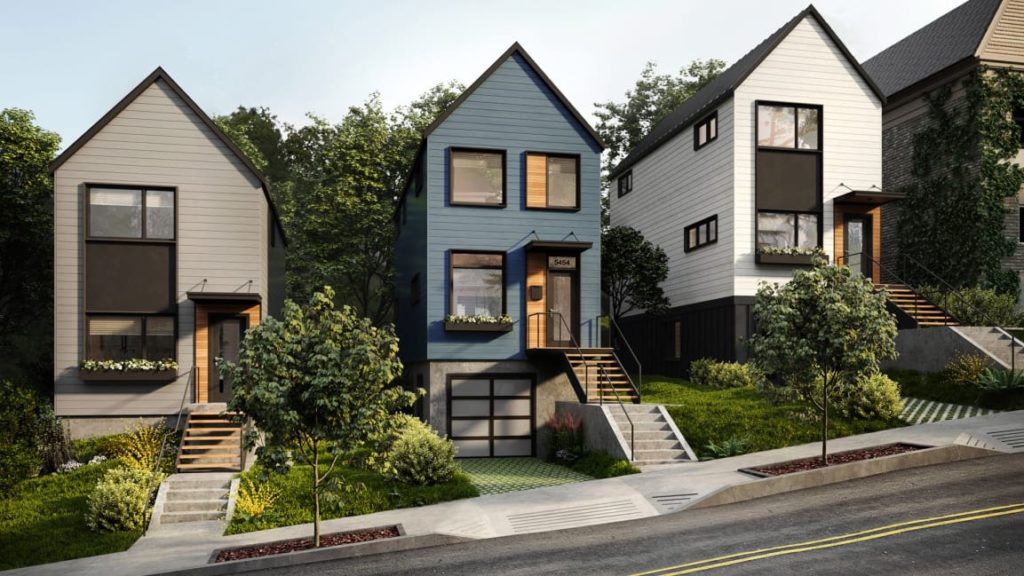[Editor’s Note: Module’s Brian Gaudio was the guest on Episode 2 of The Blueprint Sessions. This is the accompanying essay, originally published as a members-only article for members of the GEM.]
How will home design and construction processes change in the coming decade or two when car ownership isn’t a thing, grocery stores are irrelevant (since drones deliver everything in hours), and WFH is the norm?

Drone pads. Smart tech behind every appliance, door, window, and wall. Solar on every rooftop, connected to the grid. No garage; self driving will make front door pick-up and drop-off a cinch. A premium on office space and extra monetizable space means three bedrooms will no longer suffice. Kitchen technology will be expected.
Many homes are more suited to multigenerational, nontraditional households. Community isn’t conducive to turnkey, but communes will grow in popularity.
According to the WSJ, the two attributes for the house of tomorrow that overarch everything are “sustainability and technology that predicts what residents want.” The WSJ’s vision of the future:
More homes will be clad in environmentally friendly materials, built to weather the elements and conserve energy. Appliances, lights and windows would not only respond to residents’ needs but anticipate them, enabled by sensors and artificial intelligence that analyze the home’s contents and make decisions—order this, adjust that—accordingly.
During the pandemic, more people are doing activities at home that were once relegated to the office or gym. It is hard to say if this shift will last, but it has highlighted the importance for space that adapts to inhabitants’ needs.
You know, future homes will have what Bill Gates integrated into his house in the 1990’s. Yep, he had it all figured out twenty five years ago. Beyond the fact that much of the technology that cost millions then can now be had for several hundred dollars (Alexa, Nest, Latch, etc), the paradigm shift is the modularity—of tech, yes, but also construction.
BLOCK BY BLOCK
A love of LEGOS runs in the family: My nieces are on the verge of obsession with Harry Potter castles filling their rooms, and the Black Sea Barracuda was my prized toy growing up. I’ve rekindled that love during the pandemic, constructing several cars.
The idea of a full home built as expandable blocks is not a fairy tale, even today. Following on the heels of Elemental’s work in South America, Module has been working on modular homes that can be expanded using lego concepts for several years. It’s pitched as, “Everything you need. Nothing you don’t.” It’s no surprise that a family’s needs change with age, kids, lifestyle, and physical things.

The lack of expandability is one of the downsides of the mass-templatization of home construction. Another is “cookie cutter” design. But with advances in 3D printing, any “block” is easily printable, making aesthetically pleasing designs possible. Squares and rectangles stacked on top of each other is no longer the only option.
One thing is without doubt: Homes will build up. Land cost is what it is, but zoning will eventually allow developers to add square footage toward the clouds. As Sam DeBord said, “stack em high.”
FLEXIBILITY REIGNS
No matter what actual homes look like right now, the homes of tomorrow are being designed today. Builders must “Develop designs that revolve around the new paradigm of work and school from home,” says Bruce W. McNeilage, CEO Kinloch Partners.
Bumblebee Spaces already enables ceiling to floor utilization—bedrooms can double as offices and storage containers can attach to the ceiling. When paired with Module’s Lego-like building technology, future homes become truly customizable to each family’s unique needs. And when it’s time to sell? Just as one set of Lego bricks yields endless cool designs, the next family can easily mix, match, and redesign a home to its desired specifications.
Think even bigger. Removable and foldable backyard structures will lessen the friction for deploying square footage for years at a time, but then transfer and sell that structure to a home a quarter of a mile away when the need subsides. The backyard will become an even bigger hotbed of activity than it already is. Inside, you could upgrade your dream kitchen with the latest tech without a full renovation while your investment in closet and storage blocks becomes a lifetime one since they can move you.
Home builders, dig in. Literally (because, you know, earth-sheltered homes cost less to heat and cool).
Not exciting or challenging enough? You can always help the team at Purdue University working on a home for when Elon populates Mars.
-Drew Meyers

The GEM: A private & paid community connecting the boldest entrepreneurs across every proptech sector, consisting of 400+ founders, execs, VCs, and practitioners. Discover an exclusive, objective lens into the trends, companies, people, and ideas shaping the future of real estate and the broader built world: Apply here.



1 thought on “Building Blocks for Homes of Tomorrow”
Drew,
Think of all the second, third and fourth ring markets that could be resurrected under the theme of your post. These communities already have the utilities, fire, police, parks, restaurants and schools in place. An uptick in housing quality at reasonable prices should wake up some really nice communities.
I see a power real estate team playing out here – nice job gentlemen!
Thanks,
Brian
Comments are closed.